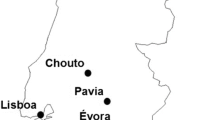Abstract
Comparability analyses are performed to investigate similarities/differences of the standard precipitation index (SPI) and the reconnaissance drought index (RDI), respectively, utilizing precipitation and ratio of precipitation over potential evapotranspiration (ET 0). Data are from stations with different climatic conditions in Iran. Drought characteristics of the 3-month, 6-month and annual SPI and RDI time series are developed and Markov chain order dependencies are investigated by the Log-likelihood, AIC and BIC tests. Steady state probabilities and Markov chain characteristics, i.e., expected residence time in different drought classes and time to reach “Near Normal” class are investigated. According to results, both indices exhibit an overall similar behaviour; particularly, they follow the first order Markov chain dependency. However, climatic variability may produce some differences. In several cases, the “Extremely Dry” class has received a more critical value by RDI. Furthermore, the expected residence time of “Near Normal” class and expected time to reach “Near Normal” class are quite different in a number of cases. The results show that the RDI by utilizing the ET 0 can be very sensitive to climatic variability. This is rather important, since if the drought analyses are for agricultural applications, utilization of the RDI would seem to serve a better purpose.
Similar content being viewed by others
References
Abolverdi J, Khalili D (2010) Probability analysis of extreme regional meteorological droughts by L-moments in a semi-arid environment. Theor Appl Climatol 102:351–366
Akaike H (1974) A new look at statistical model identification. IEEE Trans Automat Contr AC-19:716–723
Allen RG, Pereira RD, Smith M (1998) Crop evapotranspiration. Guidelines for computing crop water requirements. Irrig Drain Paper No. 56. FAO, Rome, p 300
De Martonne E (1942) Nouvelle carte mondiale de l’indice d’aridité. Ann Géogr 51:242–250
Dracup JA, Lee KS, Paulson EN Jr (1980) On the statistical characteristics of drought events. Water Resour Res 16(2):289–296
Edossa DC, Babel MS, Gupta AD (2010) Drought analysis in the Awash river basin, Ethiopia. Water Resour Manage 24:1440–1460
Edwards CD, McKee TB (1997) Characteristics of 20th century drought in the United States at multiple time scales. Atmospheric Science Paper No. 634, Climatology Report, No. 97-2, Dep Atmos Sci, Colorado State Univ
Hayes MJ, Svoboda MD, Wihite DA, Vanyarhko OV (1999) Monitoring the 1996 drought using the standardized precipitation index. Bull Am Meteorol Soc 80(3):429–438
Katz RW (1981) On some criteria for estimating the order of a Markov chain. Technometrics 23:243–249
Lohani VK, Loganathan GV (1997) An early warning system for drought management using the Palmer drought index. J Am Water Resour Assoc 33(6):1376–1386
Lohani VK, Loganathan GV, Mostaghimi S (1998) Long-term analysis and sort-term forecasting of dry spells by the Palmer drought index. Nordic Hydrol 29(1):21–40
McKee TB, Doesken NJ, Kleist J (1993) The relationship of drought frequency and duration to time scales. In: Proc. 8th Conf. on Applied Climatol, 17–22 January, Americ Meteorol Soc, Mass, pp 179–184
Mishra AK, Desai VR, Singh VP (2007) Drought forecasting using a hybrid stochastic and neural network model. J Hydrol Eng 12(6):626–638
Modarres R (2010) Regional dry spell frequency analysis by L-moment and multivariate analysis. Water Resour Manage 24:2365–2380
Morid S, Smakhtin V, Moghadasi M (2006) Comparison of seven meteorological indices for drought monitoring in Iran. Int J Climatol 26:971–985
Nalbantis I, Tsakiris G (2009) Assessment of hydrological droughts revisited. Water Resour Manag 23:881–897
Ochola WO, Kerkides P (2003) A Markov chain simulation model for predicting critical wet and dry spells in Kenya. Analysing rainfall events in the Kano plains. Irrig Drain 52(4):327–342
Pandey RP, Pandey A, Galkate RV, Byun H-R, Mal BC (2010) Integrating hydro-meteorological and physiographic factors for assessment of vulnerability to drought. Water Resour Manage 24:4199–4217
Paulo AA, Pereira LS (2006) Prediction of SPI drought class transitions using Markov chains. Water Resour Manage 21:1813–1827
Paulo AA, Pereira LS (2007) Stochastic prediction of SPI drought class transition. Water Resour Manage 22:1277–1527
Raziei TB, Saghafian Paulo AA, Pereira LS, Bordi I (2009) Spatial patterns and temporal variability of drought in western Iran. Water Resour Manage 23:439–455
Schwarz G (1978) Estimating the dimension of a model. Ann Stat 6:461–464
Steineman A (2003) Drought indicators and triggers: a stochastic approach to evaluation. J Am Water Resour Assoc 39(5):1217–1233
Tabrizi AA, Khalili D, Kamgar-Haghighi AA, Zand-Parsa Sh (2010) Utilization of time-based meteorological droughts to investigate occurrence of stramflow droughts. Water Resour Manage 24:4287–4306
Tong H (1975) Determination of the order of a Markov chain by Akaike’s Information Criterion. J Appl Prob 12:488–497
Tsakiris G (2004) Meteorological Drought Assessment. Paper prepared for the needs of the European Research Program MEDROPLAN (Mediterranean Drought Preparedness and Mitigation Planning), Zaragoza, Spain
Tsakiris G, Vangelis H (2005) Establishing a drought index incorporating evapotranspiration. Eur Water (9/10):3–11
Tsakiris G, Pangalou D, Vangelis H (2007) Regional drought assessment based on the Reconnaissance Drought Index (RDI). Water Resour Manage 21(5):821–833
Tukey JW (1977) Exploratory data analysis. Addison-Wesley, Reading
Vangelis H, Spiliotis M, Tsakiris G (2010) Drought severity assessment based on bivariate probability analysis. Water Resour Manage. doi:10.1007/s11269-010-9704-y
Vasiliades L, Loukas A, Liberis N (2010) A water balancd derived drought index for Pinios River Basin, Greece. Water Resour Manage. doi:10.1007/s11269-010-9665-1
Wilks DS (2006) Statistical methods in the atmospheric sciences, 2nd edn. Academic Press, USA
Author information
Authors and Affiliations
Corresponding author
Rights and permissions
About this article
Cite this article
Khalili, D., Farnoud, T., Jamshidi, H. et al. Comparability Analyses of the SPI and RDI Meteorological Drought Indices in Different Climatic Zones. Water Resour Manage 25, 1737–1757 (2011). https://doi.org/10.1007/s11269-010-9772-z
Received:
Accepted:
Published:
Issue Date:
DOI: https://doi.org/10.1007/s11269-010-9772-z




